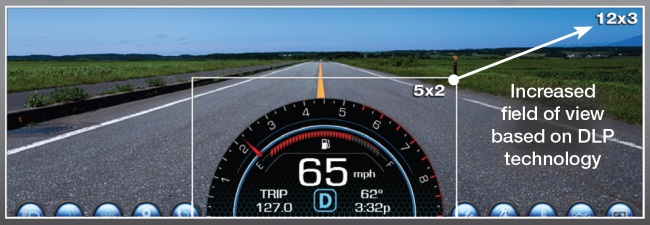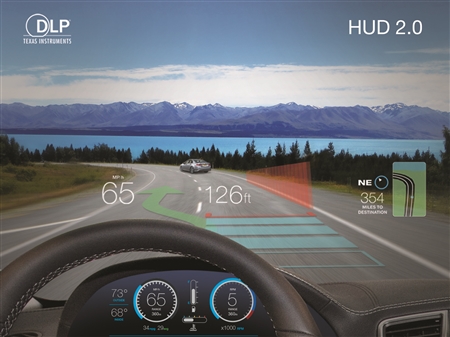BY JEFF DICKHART,
TI DLP Products Automotive Product Line Manager,
Texas Instruments,
www.ti.com
More and more new vehicles are being introduced with optional head-up displays (HUDs). Much like all displays in the vehicle, HUDs are becoming larger, and more content is making its way into the HUD as a way to help keep the driver’s eyes on the road. This poses a growing challenge to car Original Equipment Manufacturer (OEM) content developers:
– What information should be put in the HUD?
– What if the car buyer does not choose the HUD option?
-Where does all the content that would have been in the HUD now get displayed?
In order to truly unlock the potential of HUDs, a fresh, new approach toward content development may be required.
What information do we put in the HUD?
We are now seeing the introduction of new display technologies, such as DLP technology, into the automotive market. DLP technology will allow OEMs to develop wide field of view (WFOV) HUDs and augmented reality (AR) HUDs, which will provide more display real estate for car OEMs to improve the customer experience. WFOV HUDs will improve upon today’s HUDs by expanding the field of view up to 12 degrees wide or more as compared to today’s systems – which max out around 6 degrees. As the FOV grows, we are seeing more Advanced Driver Assistance System (ADAS) content make its way into the HUD – features like blind spot detection and lane departure warning. However, a larger display doesn’t simply mean that more content should be displayed at all times. The display should be used intelligently in a way that does not cause distraction. A WFOV HUD gives the car OEM the opportunity to display more content where and when it is needed, as opposed to just cramming more icons onto the screen and cluttering up the driver’s view.

Wide field of view will improve the driver experience
In addition to wide fields of view, new automotive display technologies will lead to the introduction of AR HUDs. First, let’s define AR, because there is discussion about its definition as it relates to HUD technology. For the purpose of this article, AR HUD is defined as those HUDs that substantially increase the focal distance at which the display content appears. Instead of the HUD virtual image appearing to the driver at the front of the vehicle, it will appear to the driver at 7, 10, or even up to 20m down the road. These HUDs are sometimes referred to as “contact analog” HUDs, because they will offer the capability to overlay conformal graphics on real world objects. This will make the HUD content appear more natural to the driver versus traditional HUDs and can position the HUD as the ADAS display of the future.
Today’s HUDs show redundant content
Despite advancements in WFOV and contact analog HUDs, the current paradigm of HUD development is to treat the HUD as an optional feature. This usually means the information provided is already available somewhere else in the vehicle. For example, navigation appears in the center stack. Speed appears in the cluster. ADAS information appears in the cluster or even the side view mirror. Due to the optional nature of current HUD systems, this content needs to be developed by the car maker twice: first, in a way that satisfies models purchased with a HUD and second, in a way that satisfies models purchased without one.
A new approach
What if the HUD was a standard feature? What if car OEMs could develop their Human Machine Interface (HMI) in a way that assumed a HUD is always in the vehicle? What would they use the cluster for? What content would be best put in the center stack? Possibly the answers to these questions would be different from what these displays are used for today. The HUD could become the primary display when driving. Information such as speed, navigation data, ADAS warnings, quick-glance entertainment updates, or even back-up camera video could be displayed in the HUD. The cluster could serve as a display for auxiliary information such as persistent entertainment information, trip counters, odometer, or other convenience information. The center stack could continue to serve as an interactive display for controls and information input. However, by leveraging the cluster for things like entertainment information and detailed map data, the center stack could become a smaller display focused on controls needed by both the driver and passenger such as climate controls, navigation destination input, or multimedia selection. This is just one example of how these displays could function in concert with one another instead of being redundant.

The HUD could show speed, navigation, warnings, and backup camera displays, while the cluster could display persistent entertainment info, trip counters, and odometer information
One question you may be asking is why would an OEM want to do this? The answer could be consumer loyalty. Think about the operating system (OS) on your computer. As you get used to an OS, it becomes harder to switch to a different one. When it was time to replace your computer, you likely purchased one that used the same OS as your previous one. The same can be true for vehicle HMIs. If you get used to one OEM’s approach, you can get attached to that manufacturer. The car OEM that can develop a holistic and differentiated approach to vehicle displays that includes center stack, cluster, and HUD has the opportunity to win the customer loyalty. When consumers are in the market for their next car, they can likely start with the brand they currently drive to maintain their user experience and reduce the learning curve of adopting a new HMI.
Now, some of the arguments against including HUDs as a standard feature include the cost and space required. First, let’s discuss cost. HUD system costs are coming down thanks to more volume shipments, competitive technologies entering the market, and overall engineering improvements as HUD systems mature. If we take this new approach and treat the HUD as a standard feature, additional cost optimizations are likely as volume increases. Areas such as windshields, communication interfaces, processor choices, and electronics integration are just a few of the areas where cost can be saved if HUDs were a standard feature in the vehicle. For example, one infotainment processor, such as the TI Jacinto 6 platform , could distribute all of this content to multiple displays without having to render the same graphics multiple times. One windshield could be developed per car instead of having to develop multiple windshields for the same vehicle. Eliminating component redundancy can lead to cost reductions in the system.
Now, let’s discuss packaging. HUDs require space in the vehicle design. This is a challenge. Again, if we change our paradigm, and choose to re-think why and how all the displays in the vehicle should be used, would this lead to a smaller cluster, or would the OEM eliminate the cluster entirely? Again, optimizations can be found.
New automotive display technologies are coming to market now and can enable advancements in HUDs that change the way consumers experience navigation and ADAS features in their vehicles. However, treating the HUD as a redundant display can limit the effectiveness and the adoption of this technology. By eliminating redundancies in the HMI and taking a new approach to HUD development that makes the HUD a standard feature, OEMs can unlock the true potential for head-up displays as a central component in the future HMI of the vehicle.
Advertisement
Learn more about Texas Instruments





